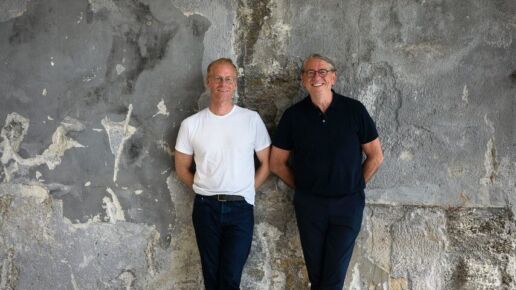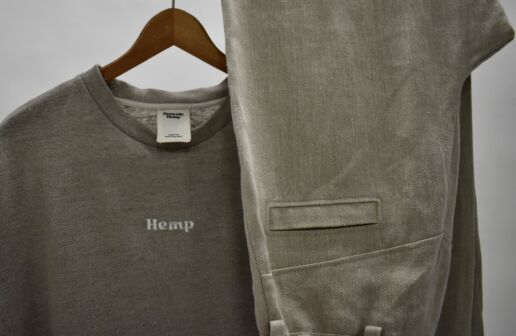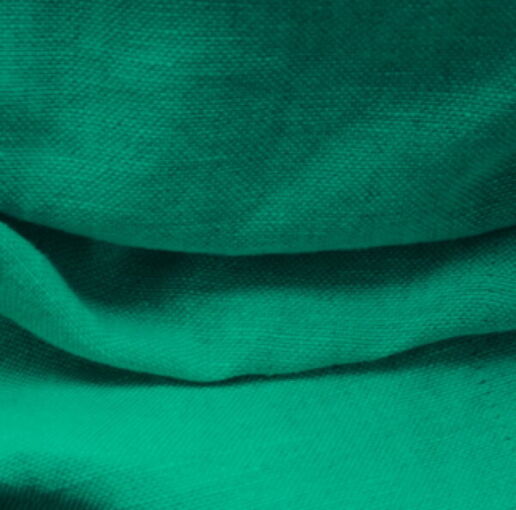Sustainable Innovations
Navigating the Future of Sustainable Innovation
Simon, this season’s Sustainable Innovations (SI) exhibit at Munich Fabric Start seems to have taken a more introspective turn. Could you share how you’ve approached the curation for this year?
Simon Angel: Absolutely. If you look at our past themes, they almost read like serialized literature. We began by exploring the challenges designers faced and the industry’s reluctance to move beyond traditional practices. Over time, our sustainable theme has woven itself into the very fabric of our industry—integrating into processes, policies, and people’s mindsets. This season, we’re continuing this saga by posing critical questions and embracing a more holistic narrative. It’s less about solutions and more about interventions and transformative thinking.
Interesting. Could you elaborate on how this philosophy manifests in the exhibited projects?
Simon Angel: Certainly. Take Suzanne Oude Hengel’s “Knit in Motion” as an example. Suzanne’s work challenges conventional knitting practices and pushes boundaries. Her exploration into combining knitting with thermoplastic polyurethane (TPU) and 3D printing isn’t just about creating new forms; it’s about questioning and redefining traditional manufacturing processes. This fusion of techniques not only rejuvenates product design but also opens up new vistas for the industry.
Joris de Groot’s work is also featured prominently. How does his approach fit into this narrative?
Simon Angel: Joris’s approach is quintessential to our theme of questioning and innovation. His “2000N Pressed Shoe” and “Recycled Raincoat” projects exemplify how traditional techniques can be reimagined for modern applications. By integrating industrial processes with sustainable practices, Joris turns waste into valuable products, thus challenging the very concept of material utility in fashion. His collaboration on the “Welded Loop” project further demonstrates how combining different techniques can lead to novel, sustainable solutions.
Tjeerd Veenhoven’s projects with mycelium are intriguing. How do they contribute to the broader narrative?
Simon Angel: Tjeerd‘s work with mycelium embodies a leap towards sustainable material innovation. His “Mycelium 2D Printing” explores the use of fungal materials to replace conventional plastics and dyes. This aligns perfectly with our theme of questioning and rethinking systems. Tjeerd’s projects aren’t just about creating sustainable alternatives; they represent a paradigm shift in how we perceive and utilize biological materials in fashion.
Iris Veentjer’s “RietGoed” project also stands out. What role does it play in this season’s exhibit?
Simon Angel: Iris’s “RietGoed” is a prime example of how material innovation can address environmental challenges. By developing high-quality textiles from reed fibers, she tackles issues like soil subsidence and CO2 emissions. Iris’s approach is a testament to how sustainable practices can be seamlessly integrated into textile production, promoting both ecological balance and economic viability.
Ilse Kremer’s “Fabulous Fungi” introduces a novel way to approach textile dyeing. How does it fit into the exhibit’s overarching theme?
Simon Angel: Ilse’s “Fabulous Fungi” project is a brilliant illustration of how we can rethink traditional processes. By utilizing fungi to produce dyes, Ilse addresses both environmental and health concerns associated with synthetic dyes. This project embodies our theme of exploring and implementing alternative solutions that are both innovative and sustainable.
Lastly, can you shed some light on the BIOTEXFUTURE initiatives and its relevance to this year’s theme?
Simon Angel: BIOTEXFUTURE is at the forefront of transitioning the textile industry to biobased materials. This initiative, which includes projects like TransitionLab and LightLining, aligns with our broader narrative of fostering systemic change. By focusing on biobased polymers and sustainable textiles, BIOTEXFUTURE is paving the way for a future where the textile industry can achieve true circularity and sustainability.
How do you see these innovations influencing the future of the textile industry?
Simon Angel: These innovations represent a profound shift in how we approach textile design and production. They challenge existing paradigms and offer new perspectives on sustainability. By fostering a culture of questioning and experimentation, we’re not just enhancing the industry’s practices but also inspiring a broader societal shift towards more sustainable and thoughtful consumption.
Simon, thank you for sharing these insights. It’s clear that this season’s SI exhibit is not just about showcasing new materials but about sparking a deeper conversation about the future of our industry.
Simon Angel: My pleasure. I invite everyone to engage with these projects and be a part of this evolving dialogue. It’s through such collective exploration that we’ll truly drive forward sustainable innovation.
We look forward to experiencing this season’s exhibit and seeing how these pioneering ideas will shape the future.
Simon Angel: Thank you. See you at the SUSTAINABLE INNOVATIONS – and don’t forget: you’ll find us at the Keyhouse in Hall 7 this season!
Discover more industry-changing innovations at our upcoming trade shows:
LOOPER Textile Co. – A second life for unwanted garments
17. December 2024
Looper Textile Co. is a trusted partner in preparing garments for the next phase of their lifecycle. The bold ambition and strong heritage of this young company lies the understanding...
SPRING.SUMMER 26 FABRIC HIGHLIGHTS & MATERIAL NOVELTIES – PART II
16. December 2024
Beautiful and contemporary prints add fresh and vibrant touches to any garment. Wild silks are offered alongside tulles with low or zero formaldehyde.
New Fabric Collection of BLOOMATI by Carvema
15. December 2024
Innovation is at the heart of our collection. We have explored new textile technologies that bring futuristic properties to fabrics.
New Fabric Collection by Paulo de Oliveira
13. December 2024
Paulo de Oliveira is a reference in sustainable production, focusing on sustainable raw materials produced in Europe by ecological processes.
SPRING.SUMMER 26 FABRIC HIGHLIGHTS & MATERIAL NOVELTIES – PART I
12. December 2024
Fashionable woven and knitted fabrics made of wool, cotton, silk, blends and functional fibres are presented by our international suppliers..
MUNICH FABRIC START & BLUEZONE – Essential and efficient
5. September 2024
INTUITION means that we have the courage to rely on our inner voice instead of just relying on hard facts and data. An interview with the organisers of MUNICH FABRIC START.
Navigating the Future of Sustainable Innovation
3. September 2024
This season, we're continuing this saga by posing critical questions and embracing a more holistic narrative. It’s less about solutions and more about interventions and transformative thinking.
INTUITION – In conversation with the organisers of MUNICH FABRIC START about the zeitgeist, trade shows and new chances
3. September 2024
INTUITION means that we have the courage to rely on our inner voice instead of just relying on hard facts and data. An interview with the organisers of MUNICH FABRIC START.
FABRIC HIGHLIGHTS & MATERIAL NOVELTIES FOR AUTUMN.WINTER 25/26 – PART VIII
3. September 2024
The claim “The best made by our hands” highlight the importance of our partners to create an high quality fabric giving the best service possible.
New Fabric Collection by BUNTASTIC
3. September 2024
Buntastic Design Studio has put together for us a “bowl” of fresh design ingredients for fall/winter 2025.
Sustainable Innovations – Suzanne Oude Hengel
Born from frustration about past experiences within the textile industry and its unwillingness to stray from the status quo, Suzanne Oude Hengel founded Knit in Motion (KiM). Her goal: to push boundaries, experiment, and challenge the way things are done. KiM breaks down traditional notions of knitting by questioning, examining, and rethinking the craft and its applications, going off the beaten track to explore new territory within textile design.

Suzanne’s graduation project (ArtEZ University of the Arts in Arnhem), “Loop Coloured Feet” (2015), explores the potential of using knitting as an alternative material in footwear. It represents a starting point for many ideas that she continues to investigate including rethinking production methods, reviving older techniques, and focusing on craftsmanship.


A tube and the shape of a sock were the starting point for “Santoni” (created at Santoni in Shanghai in 2016). Working with circular knitting machines allowed Suzanne to develop a different approach to thinking about shape.
“Working with circular knitting machines allowed Suzanne to develop a different approach to thinking about shape.”




For their 50th anniversary, Suzanne was among Timberland’s chosen collaborators for “Timberland Future 73”. Launched at Milan Design Week 2023, the collection opens with the brand’s classic styles and blends them with her world of unexpected colour and material choices, resulting in a reimagined vision for the brand as well as the application of knitted textiles.
“I believe that true innovation comes from a curious and iterative design process.” – Suzanne Oude Hengel


Suzanne’s ongoing research “Spacers” (since 2018) looks at the potential of using weft knitting technology to create spacers. Research includes experimenting with different materials, densities, and final applications. Projects like Timberland Future 73 draw from this body of research, illustrating completely different end-uses for this innovative knitted material.


With “Welded Loop”, Knit in Motion and Studio Joris de Groot collaboratively explore the innovative use of Thermoplastic Polyurethane (TPU) in shoe design by integrating knitting, welding, and 3D printing techniques. Inspired by the discovery of TPU at the Techtextil fair in Frankfurt, the project harnesses the material’s versatility and recyclability. By integrating knitting, welding, and 3D printing, “Welded Loop” not only seeks to innovate shoe design but also aims to inspire new applications and combinations of techniques in textile and material processing, paving the way for future advancements.
“Inspired by the discovery of TPU at the Techtextil fair in Frankfurt, the project harnesses the material’s versatility and recyclability.”

Explore KNIT IN MOTION BY SUZANNE OUDE HEGEL in the Sustainable Innovations Forum at KEYHOUSE in Hall 7!
THIS MIGHT BE ALSO INTERESTING FOR YOU
LOOPER Textile Co. – A second life for unwanted garments
17. December 2024
Looper Textile Co. is a trusted partner in preparing garments for the next phase of their lifecycle. The bold ambition and strong heritage of this young company lies the understanding...
SPRING.SUMMER 26 FABRIC HIGHLIGHTS & MATERIAL NOVELTIES – PART II
16. December 2024
Beautiful and contemporary prints add fresh and vibrant touches to any garment. Wild silks are offered alongside tulles with low or zero formaldehyde.
New Fabric Collection of BLOOMATI by Carvema
15. December 2024
Innovation is at the heart of our collection. We have explored new textile technologies that bring futuristic properties to fabrics.
New Fabric Collection by Paulo de Oliveira
13. December 2024
Paulo de Oliveira is a reference in sustainable production, focusing on sustainable raw materials produced in Europe by ecological processes.
SPRING.SUMMER 26 FABRIC HIGHLIGHTS & MATERIAL NOVELTIES – PART I
12. December 2024
Fashionable woven and knitted fabrics made of wool, cotton, silk, blends and functional fibres are presented by our international suppliers..
MUNICH FABRIC START & BLUEZONE – Essential and efficient
5. September 2024
INTUITION means that we have the courage to rely on our inner voice instead of just relying on hard facts and data. An interview with the organisers of MUNICH FABRIC START.
Navigating the Future of Sustainable Innovation
3. September 2024
This season, we're continuing this saga by posing critical questions and embracing a more holistic narrative. It’s less about solutions and more about interventions and transformative thinking.
INTUITION – In conversation with the organisers of MUNICH FABRIC START about the zeitgeist, trade shows and new chances
3. September 2024
INTUITION means that we have the courage to rely on our inner voice instead of just relying on hard facts and data. An interview with the organisers of MUNICH FABRIC START.
FABRIC HIGHLIGHTS & MATERIAL NOVELTIES FOR AUTUMN.WINTER 25/26 – PART VIII
3. September 2024
The claim “The best made by our hands” highlight the importance of our partners to create an high quality fabric giving the best service possible.
New Fabric Collection by BUNTASTIC
3. September 2024
Buntastic Design Studio has put together for us a “bowl” of fresh design ingredients for fall/winter 2025.
Sustainable Innovations – Studio Joris de Groot
Designer Joris de Groot often collaborates directly with factories, setting up his workplace within their grounds to get a deep understanding of their materials and innovate with their existing techniques. This allows him to blend traditional craftsmanship with industrial processes, resulting in unique and sustainable designs.
His project “2000N Pressed Shoe” (2018) emerged from his project “In4nite II” with Freudenberg, a company specializing in car interior materials. Joris explored the potential of Colback®, a material used in car upholstery, to create shoes. By understanding and experimenting with the molding process used in automotive interiors, he transformed Colback® into a fashion material. “2000N Pressed Shoe” is distinctive for its use of industrial techniques to create aesthetic details, showcasing the intricate patterns and textures that arise from this innovative process.
“By understanding and experimenting with the molding process used in automotive interiors, he transformed Colback® into a fashion material.”




“Recycled Raincoat” (2021) is another collaboration between Joris and Dolfing Druten. Together, they tackled the issue of cutting waste from rain jacket production. By researching the shapes of leftover fabric pieces, Joris developed patterns that could be welded together to form new raincoats. This approach not only minimizes waste but also transforms discarded materials into valuable products, highlighting his innovative use of existing resources to create sustainable fashion.
“This approach not only minimizes waste but also transforms discarded materials into valuable products, highlighting his innovative use of existing resources to create sustainable fashion.”
For “Weld Bag” (2013), Joris partnered with Dolfing Druten, a manufacturer of work clothes and rain gear, to develop a collection of bags. He repurposed high-frequency welding techniques typically used for creating waterbeds and rainwear to design unique bag handles and shapes.
“The factory is my playground, searching for new possibilities with the tools I can find.” – Joris de Groot


Explore STUDIO JORIS DE GROOT in the Sustainable Innovations Forum at KEYHOUSE in Hall 7!
THIS MIGHT BE ALSO INTERESTING FOR YOU
LOOPER Textile Co. – A second life for unwanted garments
17. December 2024
Looper Textile Co. is a trusted partner in preparing garments for the next phase of their lifecycle. The bold ambition and strong heritage of this young company lies the understanding...
SPRING.SUMMER 26 FABRIC HIGHLIGHTS & MATERIAL NOVELTIES – PART II
16. December 2024
Beautiful and contemporary prints add fresh and vibrant touches to any garment. Wild silks are offered alongside tulles with low or zero formaldehyde.
New Fabric Collection of BLOOMATI by Carvema
15. December 2024
Innovation is at the heart of our collection. We have explored new textile technologies that bring futuristic properties to fabrics.
New Fabric Collection by Paulo de Oliveira
13. December 2024
Paulo de Oliveira is a reference in sustainable production, focusing on sustainable raw materials produced in Europe by ecological processes.
SPRING.SUMMER 26 FABRIC HIGHLIGHTS & MATERIAL NOVELTIES – PART I
12. December 2024
Fashionable woven and knitted fabrics made of wool, cotton, silk, blends and functional fibres are presented by our international suppliers..
MUNICH FABRIC START & BLUEZONE – Essential and efficient
5. September 2024
INTUITION means that we have the courage to rely on our inner voice instead of just relying on hard facts and data. An interview with the organisers of MUNICH FABRIC START.
Navigating the Future of Sustainable Innovation
3. September 2024
This season, we're continuing this saga by posing critical questions and embracing a more holistic narrative. It’s less about solutions and more about interventions and transformative thinking.
INTUITION – In conversation with the organisers of MUNICH FABRIC START about the zeitgeist, trade shows and new chances
3. September 2024
INTUITION means that we have the courage to rely on our inner voice instead of just relying on hard facts and data. An interview with the organisers of MUNICH FABRIC START.
FABRIC HIGHLIGHTS & MATERIAL NOVELTIES FOR AUTUMN.WINTER 25/26 – PART VIII
3. September 2024
The claim “The best made by our hands” highlight the importance of our partners to create an high quality fabric giving the best service possible.
New Fabric Collection by BUNTASTIC
3. September 2024
Buntastic Design Studio has put together for us a “bowl” of fresh design ingredients for fall/winter 2025.
Sustainable Innovations – Studio Tjeerd Veenhoven
Studio Tjeerd Veenhoven (STV) is dedicated to material research and value chain design with a focus on sustainability. Graduating from the Art Academy in Arnhem in 2000, Tjeerd transitioned from product design to exploring sustainable value chains. Over the past 15 years, he has collaborated with numerous partners to create innovative solutions that address complex social issues related to sustainability. He acknowledges the urgent need for sustainable practices, particularly within the fashion industry.
Tjeerd’s “Mycelium 2D Printing” explores the potential of mycelium, a natural material obtained from mushrooms, which could be crucial for the transition towards more sustainable consumption. STV began researching mycelium four years ago, focusing on controlled growth without specific applications. Recently, they developed a printer that places inoculated substrates to cultivate mycelium into white dots, forming a graphical mycelium print. This speculative research envisions replacing PVC banners at cultural festivals with mycelium-printed canvas, which can be reused and reprinted without chemicals.


Another significant lead is the development of sustainable textiles from oyster mushroom mycelium. For three years, STV has investigated the potential applications of oyster mushroom waste, creating textiles from thinly sliced mushroom bases. His research revealed the mycelium’s capacity for continued growth from the mushroom foot after harvest. By allowing the material to grow back together in controlled conditions, a unique textile-like material is produced.
“In our transition to a sustainable fashion value chain, we need wild ideas that shake up, that offer a fresh perspective on raw materials, manufacturing, design and use. Mycelium based textiles are one of the more speculative routes – but with great potential.” – Tjeerd Veenhoven



THE PRINTING PROCESS – EXPERIENCE THE PRINTER LIVE AT KEYHOUSE



Explore STUDIO TJEERD VEENHOVEN in the Sustainable Innovations Forum at KEYHOUSE in Hall 7!
THIS MIGHT BE ALSO INTERESTING FOR YOU
LOOPER Textile Co. – A second life for unwanted garments
17. December 2024
Looper Textile Co. is a trusted partner in preparing garments for the next phase of their lifecycle. The bold ambition and strong heritage of this young company lies the understanding...
SPRING.SUMMER 26 FABRIC HIGHLIGHTS & MATERIAL NOVELTIES – PART II
16. December 2024
Beautiful and contemporary prints add fresh and vibrant touches to any garment. Wild silks are offered alongside tulles with low or zero formaldehyde.
New Fabric Collection of BLOOMATI by Carvema
15. December 2024
Innovation is at the heart of our collection. We have explored new textile technologies that bring futuristic properties to fabrics.
New Fabric Collection by Paulo de Oliveira
13. December 2024
Paulo de Oliveira is a reference in sustainable production, focusing on sustainable raw materials produced in Europe by ecological processes.
SPRING.SUMMER 26 FABRIC HIGHLIGHTS & MATERIAL NOVELTIES – PART I
12. December 2024
Fashionable woven and knitted fabrics made of wool, cotton, silk, blends and functional fibres are presented by our international suppliers..
MUNICH FABRIC START & BLUEZONE – Essential and efficient
5. September 2024
INTUITION means that we have the courage to rely on our inner voice instead of just relying on hard facts and data. An interview with the organisers of MUNICH FABRIC START.
Navigating the Future of Sustainable Innovation
3. September 2024
This season, we're continuing this saga by posing critical questions and embracing a more holistic narrative. It’s less about solutions and more about interventions and transformative thinking.
INTUITION – In conversation with the organisers of MUNICH FABRIC START about the zeitgeist, trade shows and new chances
3. September 2024
INTUITION means that we have the courage to rely on our inner voice instead of just relying on hard facts and data. An interview with the organisers of MUNICH FABRIC START.
FABRIC HIGHLIGHTS & MATERIAL NOVELTIES FOR AUTUMN.WINTER 25/26 – PART VIII
3. September 2024
The claim “The best made by our hands” highlight the importance of our partners to create an high quality fabric giving the best service possible.
New Fabric Collection by BUNTASTIC
3. September 2024
Buntastic Design Studio has put together for us a “bowl” of fresh design ingredients for fall/winter 2025.
Sustainable Innovations – RietGoed by Iris Veentjer
Designer Iris Veentjer, owner of Studio i Focus, is dedicated to innovative material research and experimental design to foster a regenerative world. Since 2018, she has created products raising awareness about environmental and social issues. The Netherlands faces significant soil subsidence and greenhouse gas emissions due to peatlands being drained for cattle grazing, which leads to plant decomposition and CO2 release. To address this, alternative agricultural methods like wetland cultivation are being explored.
A type of plant that thrives in wet conditions are cattails, the cultivation of which is currently not profitable for farmers, which is why its fibres are typically used for low-value products like insulation. Iris’s project, RietGoed, aims to develop high-quality textiles from cattails.
Iris developed a machine to mechanically extract fibers from cattails, allowing them to be processed like linen. This innovative approach can help reduce soil subsidence and emissions while creating a biocircular production process utilizing all parts of the plant.
With RietGoed, Iris aims to inspire broader adoption of sustainable practices and scale up textile production.
“Textiles made from cattails could potentially replace synthetic oil-based yarns. I aim to have the process from plant to fiber to product be fully biocircular. After multiple recyclings, textiles can return to the fields, contributing to peatland restoration,” she summarizes.




“RietGoed can be a solution to the nitrogen problem in peat meadow areas. By draining these areas, the soil sinks and nitrogen is released into the air. If we grow cattails on peat meadows in watery peat soil and make clothing from them, farmers will have the opportunity to earn money with this new crop.” – Iris Veentjer




Explore RIETGOED BY IRIS VEENTJER in the Sustainable Innovations Forum at KEYHOUSE in Hall 7!
THIS MIGHT BE ALSO INTERESTING FOR YOU
LOOPER Textile Co. – A second life for unwanted garments
17. December 2024
Looper Textile Co. is a trusted partner in preparing garments for the next phase of their lifecycle. The bold ambition and strong heritage of this young company lies the understanding...
SPRING.SUMMER 26 FABRIC HIGHLIGHTS & MATERIAL NOVELTIES – PART II
16. December 2024
Beautiful and contemporary prints add fresh and vibrant touches to any garment. Wild silks are offered alongside tulles with low or zero formaldehyde.
New Fabric Collection of BLOOMATI by Carvema
15. December 2024
Innovation is at the heart of our collection. We have explored new textile technologies that bring futuristic properties to fabrics.
New Fabric Collection by Paulo de Oliveira
13. December 2024
Paulo de Oliveira is a reference in sustainable production, focusing on sustainable raw materials produced in Europe by ecological processes.
SPRING.SUMMER 26 FABRIC HIGHLIGHTS & MATERIAL NOVELTIES – PART I
12. December 2024
Fashionable woven and knitted fabrics made of wool, cotton, silk, blends and functional fibres are presented by our international suppliers..
MUNICH FABRIC START & BLUEZONE – Essential and efficient
5. September 2024
INTUITION means that we have the courage to rely on our inner voice instead of just relying on hard facts and data. An interview with the organisers of MUNICH FABRIC START.
Navigating the Future of Sustainable Innovation
3. September 2024
This season, we're continuing this saga by posing critical questions and embracing a more holistic narrative. It’s less about solutions and more about interventions and transformative thinking.
INTUITION – In conversation with the organisers of MUNICH FABRIC START about the zeitgeist, trade shows and new chances
3. September 2024
INTUITION means that we have the courage to rely on our inner voice instead of just relying on hard facts and data. An interview with the organisers of MUNICH FABRIC START.
FABRIC HIGHLIGHTS & MATERIAL NOVELTIES FOR AUTUMN.WINTER 25/26 – PART VIII
3. September 2024
The claim “The best made by our hands” highlight the importance of our partners to create an high quality fabric giving the best service possible.
New Fabric Collection by BUNTASTIC
3. September 2024
Buntastic Design Studio has put together for us a “bowl” of fresh design ingredients for fall/winter 2025.
Sustainable Innovations - Ilse Kremer
Due to the extensive use of harmful chemicals in the fashion industry, synthetic textile dyes are a significant threat to sustainability. They contribute to water pollution as dye residues enter factory wastewater and rivers and can even lead to serious health issues for people handling them. Additionally, synthetic dyeing processes require substantial use of water and energy. Ilse Kremer, the mastermind behind “Fabulous Fungi”, addresses these issues by utilizing fungi to create sustainable textile dyes.




“Fabulous Fungi employs fungi in order to create sustainable and safe textile dye. Fungi use biochemical processes to produce pigments, making the impact different from fossil-based heat and extraction processes.”
This approach uses no harmful chemicals and requires much less water. The fungal pigments, which form the basis of these textile dyes, are biodegradable, ensuring that any remnants in wastewater do not pollute water sources. Furthermore, they are completely safe for both the workers handling them and consumers wearing the dyed garments, eliminating associated health risks.
Fungal dyes thus offer numerous advantages over synthetic dyes and other alternatives and present a promising solution to the environmental and health challenges posed by traditional textile dyeing methods.
“Fabulous Fungi employs fungi in order to create sustainable and safe textile dye. Fungi use biochemical processes to produce pigments, making the impact different from fossil-based heat and extraction processes.”





Explore FABULOUS FUNGI BY ILSE KREMER in the Sustainable Innovations Form at KEYHOUSE in Hall 7!
THIS MIGHT BE ALSO INTERESTING FOR YOU
LOOPER Textile Co. – A second life for unwanted garments
17. December 2024
Looper Textile Co. is a trusted partner in preparing garments for the next phase of their lifecycle. The bold ambition and strong heritage of this young company lies the understanding...
SPRING.SUMMER 26 FABRIC HIGHLIGHTS & MATERIAL NOVELTIES – PART II
16. December 2024
Beautiful and contemporary prints add fresh and vibrant touches to any garment. Wild silks are offered alongside tulles with low or zero formaldehyde.
New Fabric Collection of BLOOMATI by Carvema
15. December 2024
Innovation is at the heart of our collection. We have explored new textile technologies that bring futuristic properties to fabrics.
New Fabric Collection by Paulo de Oliveira
13. December 2024
Paulo de Oliveira is a reference in sustainable production, focusing on sustainable raw materials produced in Europe by ecological processes.
SPRING.SUMMER 26 FABRIC HIGHLIGHTS & MATERIAL NOVELTIES – PART I
12. December 2024
Fashionable woven and knitted fabrics made of wool, cotton, silk, blends and functional fibres are presented by our international suppliers..
MUNICH FABRIC START & BLUEZONE – Essential and efficient
5. September 2024
INTUITION means that we have the courage to rely on our inner voice instead of just relying on hard facts and data. An interview with the organisers of MUNICH FABRIC START.
Navigating the Future of Sustainable Innovation
3. September 2024
This season, we're continuing this saga by posing critical questions and embracing a more holistic narrative. It’s less about solutions and more about interventions and transformative thinking.
INTUITION – In conversation with the organisers of MUNICH FABRIC START about the zeitgeist, trade shows and new chances
3. September 2024
INTUITION means that we have the courage to rely on our inner voice instead of just relying on hard facts and data. An interview with the organisers of MUNICH FABRIC START.
FABRIC HIGHLIGHTS & MATERIAL NOVELTIES FOR AUTUMN.WINTER 25/26 – PART VIII
3. September 2024
The claim “The best made by our hands” highlight the importance of our partners to create an high quality fabric giving the best service possible.
New Fabric Collection by BUNTASTIC
3. September 2024
Buntastic Design Studio has put together for us a “bowl” of fresh design ingredients for fall/winter 2025.
Sustainable Innovations - Biotexfuture
BIOTEXFUTURE is an innovation initiative funded by the German Federal Ministry of Education and Research in collaboration with RWTH Aachen University and adidas AG. It aims to transform the textile industry from petroleum-based to bio-based materials, promoting sustainability and bioeconomy. By working with industry and research partners, BIOTEXFUTURE supports the development of bio-based textiles through various projects and innovation spaces. The initiative focuses on creating sustainable raw materials, advancing biopolymer technology, and facilitating a societal shift towards eco-friendly textile solutions.
The TransitionLab, led by the Institute of Textile Technology at RWTH Aachen University (ITA) in collaboration with adidas, focuses on the big picture: creating a sustainable, bio-based textile industry. This involves creating closed-loop systems where materials can be reused and recycled, reducing waste and promoting resource efficiency. One of the key goals is to enhance the environmental performance of textiles by developing bio-based materials that can be used in various applications, including technical textiles, automotive, clothing, and home textiles.


The LightLining project in collaboration with adidas aims to develop sustainable insulating textiles made entirely from aerogel fibers. At the heart of the project are cellulose aerogel textiles that, unlike traditional rigid aerogel products, are both flexible and highly insulating. These textiles combine the benefits of aerogels, such as lightweight and superior thermal insulation, with the flexibility and processability of conventional textiles. This innovative approach promises a cost-effective and scalable solution for energy-efficient applications.
FungalFibers is another collaborative project between the ITA and adidas, aiming to develop sustainable textile solutions using fungal-derived materials. This innovative project explores the use of fungal fibers as a renewable, bio-based alternative to traditional synthetic fibers in the textile industry. Fungal fibers offer several environmental benefits, such as biodegradability and reduced reliance on fossil fuels. The project focuses on optimizing the production process of fungal fibers to ensure they meet the performance standards required for various textile applications.


BioTurf is a sustainable, next-generation artificial turf made from bio-based polymers. Traditional hybrid grass, as used in international tournaments such as the 2024 European Football Championships, combines natural and synthetic fibers which is not environmentally sustainable due to intensive maintenance and difficult disposal. BioTurf can significantly reduce CO2 emissions and water pollution since it uses biodegradable fungal pigments for coloring and requires no harmful chemicals, making it an eco-friendly and durable alternative for sports fields. Thermobonding, the new method employed for the development of BioTurf, avoids energy-intensive latex backing, making it nearly fully recyclable. BioTurf not only meets FIFA standards but also supports the circular economy by using non-food agricultural waste to foster a more sustainable future for sports infrastructure.
“We are delighted to be taking part in Munich Fabric Start in September. This time, we are turning the trade fair into a real-life laboratory and invite all visitors to support us in our research activities. Newly developed products have the potential to have an immediate impact on our everyday lives – this is why people and their needs should be involved in research at an early stage.”

BioTurf

FungalFibers

TransitionLab

LightLining
Visit BIOTEXFUTURE H7 KH | K 14
THIS MIGHT BE ALSO INTERESTING FOR YOU
LOOPER Textile Co. – A second life for unwanted garments
17. December 2024
Looper Textile Co. is a trusted partner in preparing garments for the next phase of their lifecycle. The bold ambition and strong heritage of this young company lies the understanding...
SPRING.SUMMER 26 FABRIC HIGHLIGHTS & MATERIAL NOVELTIES – PART II
16. December 2024
Beautiful and contemporary prints add fresh and vibrant touches to any garment. Wild silks are offered alongside tulles with low or zero formaldehyde.
New Fabric Collection of BLOOMATI by Carvema
15. December 2024
Innovation is at the heart of our collection. We have explored new textile technologies that bring futuristic properties to fabrics.
New Fabric Collection by Paulo de Oliveira
13. December 2024
Paulo de Oliveira is a reference in sustainable production, focusing on sustainable raw materials produced in Europe by ecological processes.
SPRING.SUMMER 26 FABRIC HIGHLIGHTS & MATERIAL NOVELTIES – PART I
12. December 2024
Fashionable woven and knitted fabrics made of wool, cotton, silk, blends and functional fibres are presented by our international suppliers..
MUNICH FABRIC START & BLUEZONE – Essential and efficient
5. September 2024
INTUITION means that we have the courage to rely on our inner voice instead of just relying on hard facts and data. An interview with the organisers of MUNICH FABRIC START.
Navigating the Future of Sustainable Innovation
3. September 2024
This season, we're continuing this saga by posing critical questions and embracing a more holistic narrative. It’s less about solutions and more about interventions and transformative thinking.
INTUITION – In conversation with the organisers of MUNICH FABRIC START about the zeitgeist, trade shows and new chances
3. September 2024
INTUITION means that we have the courage to rely on our inner voice instead of just relying on hard facts and data. An interview with the organisers of MUNICH FABRIC START.
FABRIC HIGHLIGHTS & MATERIAL NOVELTIES FOR AUTUMN.WINTER 25/26 – PART VIII
3. September 2024
The claim “The best made by our hands” highlight the importance of our partners to create an high quality fabric giving the best service possible.
New Fabric Collection by BUNTASTIC
3. September 2024
Buntastic Design Studio has put together for us a “bowl” of fresh design ingredients for fall/winter 2025.
The Warp Of Symbiogenesis - Sustainable Innovations
In the universe of “The Warp of Symbiogenesis,” a collection of woven fabrics unfolds, aiming to foster appreciation for the intricate interconnections among Earth’s organisms. These fabrics carry five stories of invisible connections, narrating tales of cooperation, exploitation, and competition among fungi, lichens, corals, and plants. Each symbiotic relationship inspires a distinct weaving pattern, symbolizing the unique interactions between two species. Crafted from natural fibers sourced in Europe, the textile collection invites a reconsideration of the impact and interdependence shared by all organic life forms.
How do we begin to listen to the stories of the planet? By being present in the interweaving of life, of which we are a part and always have been. As a queer speculator, designer, and researcher, Paul Schaffer is fascinated by the systems influencing our social behavior and relationship with nature. Concentrating on visual media and textiles, his work seeks to deconstruct and visually articulate the heteronormative nature of these systems. Motivated by profound curiosity and a love for research, Schaffer continually strives to comprehend systems in novel ways, addressing sensitive topics with utmost care.



———————————————————————–
DIES KÖNNTE SIE AUCH INTERESSIEREN
LOOPER Textile Co. – A second life for unwanted garments
17. December 2024
Looper Textile Co. is a trusted partner in preparing garments for the next phase of their lifecycle. The bold ambition and strong heritage of this young company lies the understanding...
SPRING.SUMMER 26 FABRIC HIGHLIGHTS & MATERIAL NOVELTIES – PART II
16. December 2024
Beautiful and contemporary prints add fresh and vibrant touches to any garment. Wild silks are offered alongside tulles with low or zero formaldehyde.
New Fabric Collection of BLOOMATI by Carvema
15. December 2024
Innovation is at the heart of our collection. We have explored new textile technologies that bring futuristic properties to fabrics.
Honestly Hemp - Sustainable Innovations
Hemp: a truly versatile plant, once one of the main sources of man-made textiles. Today, most of us know it under the names “cannabis” or “marijuana”, which tend to evoke predominantly negative connotations. Design Academy Eindhoven alumna Natasha Amisha sought to investigate the source of this disconnect with her graduate project “Honestly Hemp”. Her vision: to create an entire outfit made wholly from hemp fibre and end the stigma surrounding the plant.
Natasha soon discovered that our tainted view of the hemp plant is mainly based on misconceptions, and that it could be a key ingredient in helping the textile industry become more sustainable. Not only is hemp a robust plant that thrives in diverse conditions, it also requires minimal water, is among nature’s strongest fibers, thus ensuring long-lasting life cycles, boosts sustainable agriculture as it enhances soil quality and is antibacterial, UV resistant and hypoallergenic. With “Honestly Hemp”, she has set out to place this fascinating natural material at the forefront of sustainable solutions for the future of the textile industry.
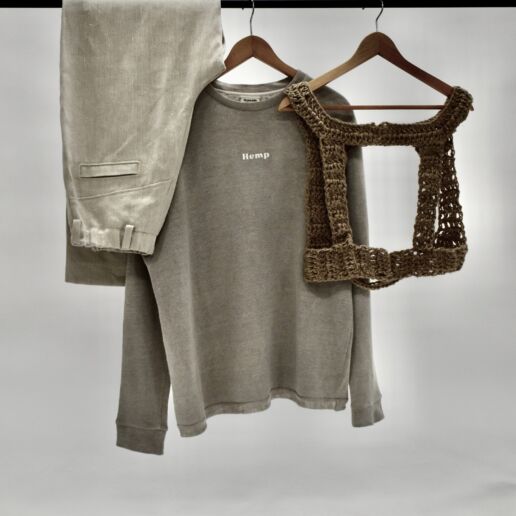
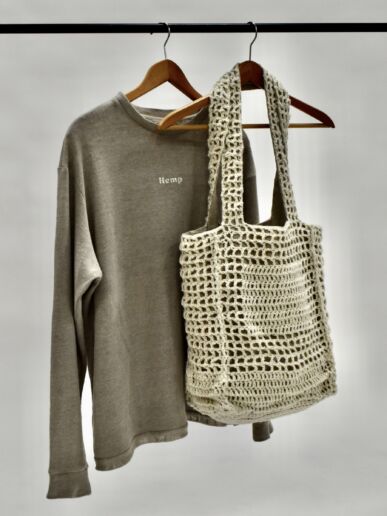
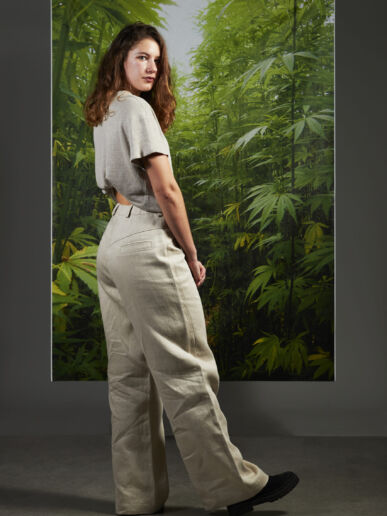
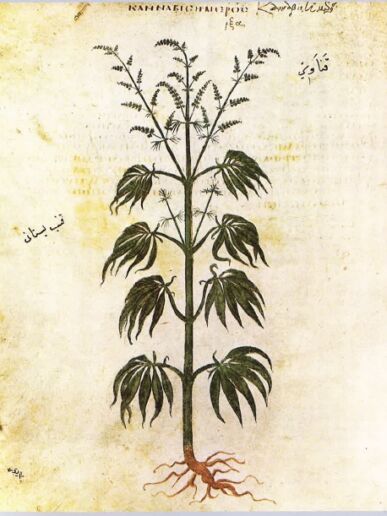
———————————————————————–
THIS MIGHT BE ALSO INTERESTING FOR YOU
LOOPER Textile Co. – A second life for unwanted garments
17. December 2024
Looper Textile Co. is a trusted partner in preparing garments for the next phase of their lifecycle. The bold ambition and strong heritage of this young company lies the understanding...
SPRING.SUMMER 26 FABRIC HIGHLIGHTS & MATERIAL NOVELTIES – PART II
16. December 2024
Beautiful and contemporary prints add fresh and vibrant touches to any garment. Wild silks are offered alongside tulles with low or zero formaldehyde.
New Fabric Collection of BLOOMATI by Carvema
15. December 2024
Innovation is at the heart of our collection. We have explored new textile technologies that bring futuristic properties to fabrics.
BioBase - Sustainable innovations
BIOBASE, a central project within the BIOTEXFUTURE cluster, introduces sustainable alternatives from available resources for textile applications with competitive costs and properties. The overarching BIOTEXFUTURE project, led by the Institute for Textile Technology at RWTH Aachen (ITA), the Chair for Technology and Organizational Sociology (STO) at RWTH Aachen, and sportswear manufacturer adidas, aims for the transition of the entire textile value
chain to biobased materials.
BIOBASE is motivated by the challenge of dependence on fossil raw materials in the production of synthetic polymers, which poses ecological, economic, and political risks. The project targets the establishment of biobased polymers in the textile industry, demonstrating their full potential. Key sectors of the German textile industry, including automotive, sportswear, interiors, and technical textiles, are the focal points.
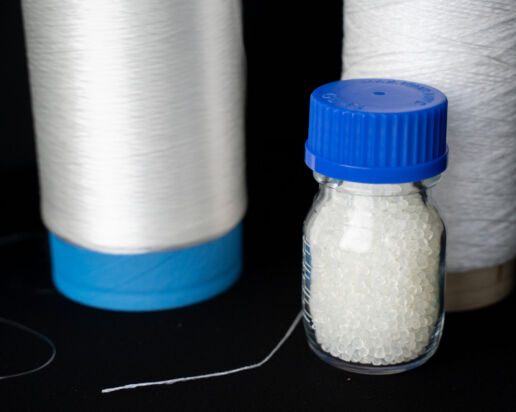
Within the BIOBASE project, the entire textile value chain of selected products is traversed. By gradually increasing the technological maturity level from Technology Readiness Level (TRL) 4 to TRL 6–7, the industrial production of biobased and sustainable man-made fibers is advanced. Polymers, yarns, and textile surfaces are developed based on applications, considering technical requirements of the industries.
The collaboration between research institutions and industrial partners allows the creation of industrially produced demonstrators, unfolding a beacon effect for the German bioeconomy and showcasing the potential of biobased polymers available in the market. The project also identifies further research and development potential for the BIOTEXFUTURE innovation area, which can be implemented in subsequent sub-projects.
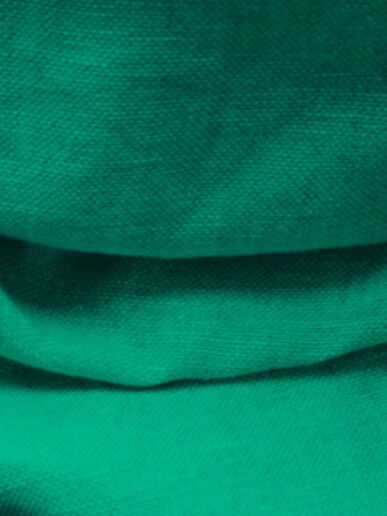
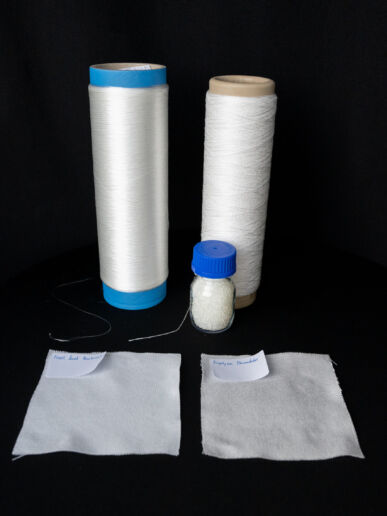
———————————————————————–
THIS MIGHT BE ALSO INTERESTING FOR YOU
LOOPER Textile Co. – A second life for unwanted garments
17. December 2024
Looper Textile Co. is a trusted partner in preparing garments for the next phase of their lifecycle. The bold ambition and strong heritage of this young company lies the understanding...
SPRING.SUMMER 26 FABRIC HIGHLIGHTS & MATERIAL NOVELTIES – PART II
16. December 2024
Beautiful and contemporary prints add fresh and vibrant touches to any garment. Wild silks are offered alongside tulles with low or zero formaldehyde.
New Fabric Collection of BLOOMATI by Carvema
15. December 2024
Innovation is at the heart of our collection. We have explored new textile technologies that bring futuristic properties to fabrics.

















